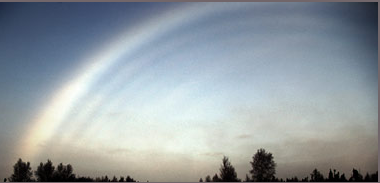Fogbow near Thompson,Manitoba, Canada
Fogbow near Thompson, Manitoba, Canada: Exploring the Phenomenon
Fogbows, also known as white rainbows or ghost rainbows, are captivating atmospheric optical phenomena that occur under specific weather conditions. While they may resemble rainbows, fogbows have their unique characteristics that set them apart. One remarkable example of a fogbow was imaged by Larry Hall on December 26, 2007, near Thompson, Manitoba, Canada. In this article, we will delve into the details of this extraordinary fogbow and explore the factors that contribute to its formation.
The temperature during the occurrence of this fogbow was an icy -26°C, creating a frigid environment. It is interesting to note that fogbows can form in temperatures below freezing, as long as the water droplets are in a supercooled state. Supercooled water droplets are liquid at temperatures below freezing due to the absence of ice nuclei to initiate freezing. In such conditions, the fogbow's appearance can be enhanced by the presence of ice crystals within the fog.
What makes this particular fogbow near Thompson, Manitoba even more fascinating is the presence of three supernumerary bows within the primary bow. Supernumerary bows are additional faint arcs that appear inside the primary rainbow or fogbow. These bows result from the interference of light waves as they pass through water droplets. The precise conditions required for the formation of supernumerary bows contribute to their rarity and make them a captivating sight for observers.
Additionally, there is a faint outer secondary bow visible in the image captured by Larry Hall. Secondary bows occur when light is reflected twice within a raindrop or water droplet. This double reflection causes the secondary bow to appear at a larger angle than the primary bow. The faintness of the outer secondary bow in this particular fogbow may be attributed to various factors such as droplet size and shape.
The contrast-enhanced view of the fogbow provides a clearer representation of its features, allowing us to appreciate the intricate details. The enhanced contrast reveals the distinct bands of color within the fogbow, ranging from violet on the inner edge to red on the outer edge. These colors result from the dispersion of sunlight as it interacts with the water droplets in the fog. The droplets act as tiny prisms, separating the white light into its component colors.
Fogbows are commonly observed in areas with fog or mist, where there is a sufficient concentration of water droplets suspended in the air. The droplets act as scattering centers for sunlight, causing the fogbow to appear. In this case, Thompson, Manitoba, experienced the ideal atmospheric conditions for the formation of a fogbow, resulting in this remarkable sighting captured by Larry Hall.
It is worth mentioning that fogbows are typically less vibrant than rainbows due to the smaller size of the water droplets involved. The smaller droplet size limits the amount of light that is diffracted and scattered, resulting in a less saturated appearance. However, the subtle beauty of fogbows lies in their ethereal and delicate nature.
In conclusion, the fogbow imaged near Thompson, Manitoba, Canada, presents a captivating example of this atmospheric optical phenomenon. The presence of three supernumerary bows within the primary bow and the faint outer secondary bow add to the uniqueness of this sighting. Understanding the factors contributing to the formation of fogbows allows us to appreciate their beauty and comprehend the science behind these enchanting natural spectacles.

Fogbow imaged by Larry Hall on December 26, 2007 near Thompson, Manitoba, Canada. The temperature was -26C and the air still. The bow is unusual in that there are three supernumeraries inside the primary bow as can be seen in the contrast enhanced view below. There is also a faint outer secondary bow. Image ©Larry Hall, shown with permission.

Note: this article has been automatically converted from the old site and may not appear as intended. You can find the original article here.
Reference Atmospheric Optics
If you use any of the definitions, information, or data presented on Atmospheric Optics, please copy the link or reference below to properly credit us as the reference source. Thank you!
-
<a href="https://atoptics.co.uk/blog/fogbow-near-thompson-manitoba-canada/">Fogbow near Thompson,Manitoba, Canada</a>
-
"Fogbow near Thompson,Manitoba, Canada". Atmospheric Optics. Accessed on November 26, 2024. https://atoptics.co.uk/blog/fogbow-near-thompson-manitoba-canada/.
-
"Fogbow near Thompson,Manitoba, Canada". Atmospheric Optics, https://atoptics.co.uk/blog/fogbow-near-thompson-manitoba-canada/. Accessed 26 November, 2024
-
Fogbow near Thompson,Manitoba, Canada. Atmospheric Optics. Retrieved from https://atoptics.co.uk/blog/fogbow-near-thompson-manitoba-canada/.